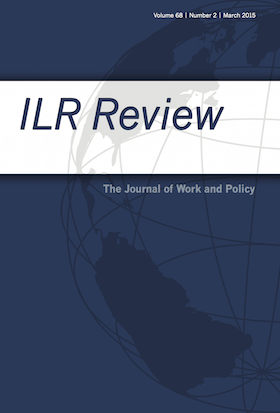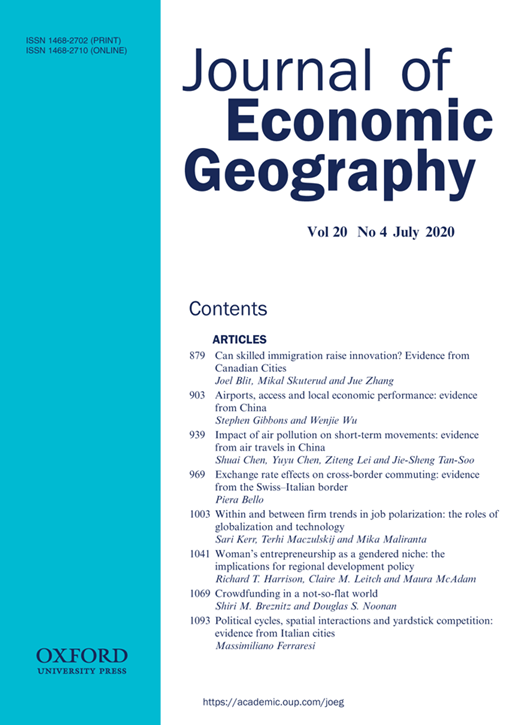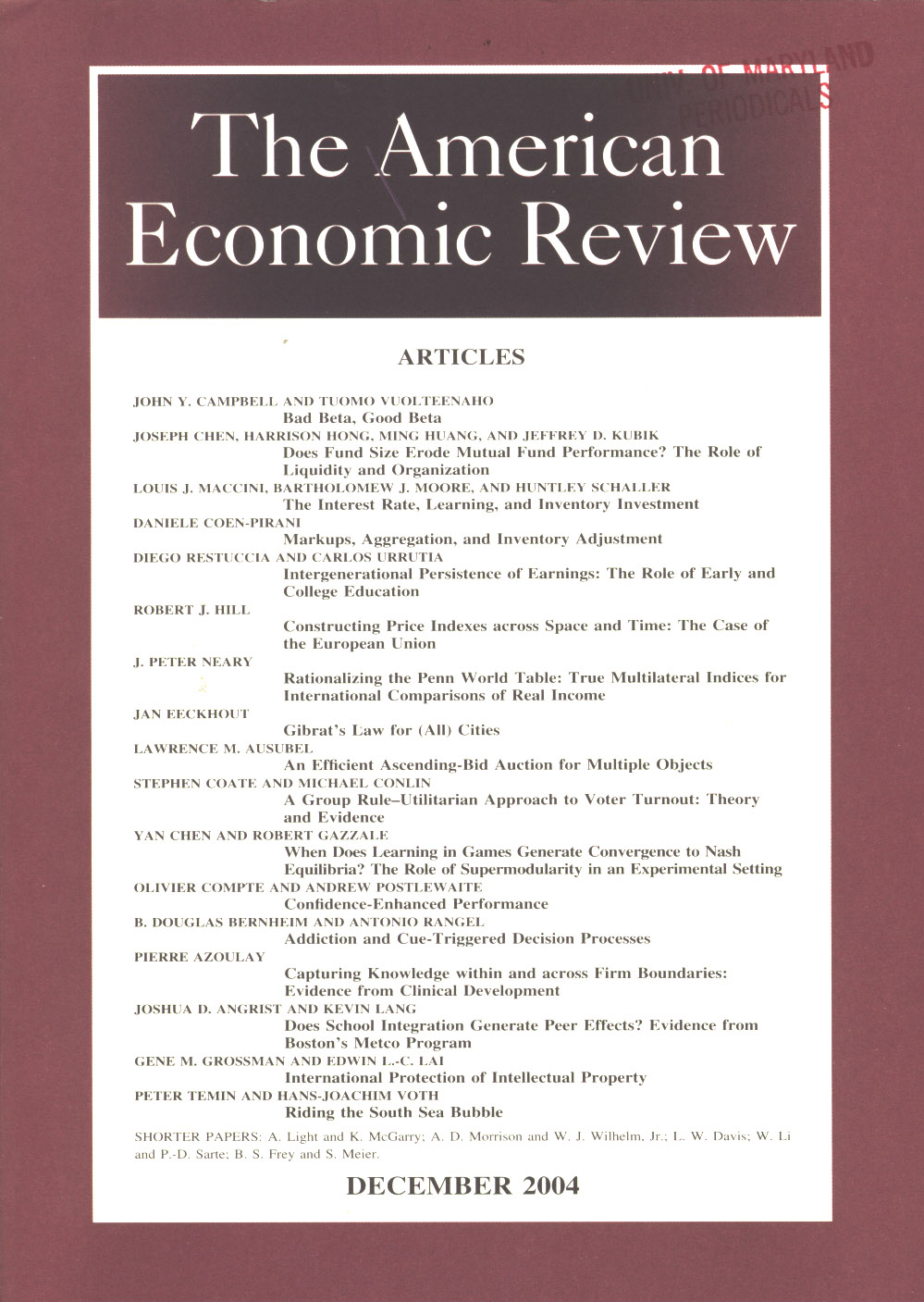Entrepreneurship, Innovation, and Productivity Growth
This group tackles research topics that are of relevance for our understanding of patterns of innovation and productivity growth and explores implications for workers and firms. Areas of particular focus include the decline in business dynamism, the growth in automation, entrepreneurship and innovation, and supply chains.
Research Cluster
Productivity and InstitutionsYour contact

Mitglied - Department Structural Change and Productivity
Refereed Publications

Measuring Job Creation, Growth, and Survival among the Universe of Start-ups in the United States Using a Combined Start-up Panel Data Set
in: ILR Review, No. 5, 2019
Abstract
The field of entrepreneurship is growing rapidly and expanding into new areas. This article presents a new compilation of administrative panel data on the universe of business start-ups in the United States, which will be useful for future research in entrepreneurship. To create the US start-up panel data set, the authors link the universe of non-employer firms to the universe of employer firms in the Longitudinal Business Database (LBD). Start-up cohorts of more than five million new businesses per year, which create roughly three million jobs, can be tracked over time. To illustrate the potential of the new start-up panel data set for future research, the authors provide descriptive statistics for a few examples of research topics using a representative start-up cohort.

Taken by Storm: Business Financing and Survival in the Aftermath of Hurricane Katrina
in: Journal of Economic Geography, No. 6, 2018
Abstract
We use Hurricane Katrina’s damage to the Mississippi coast in 2005 as a natural experiment to study business survival in the aftermath of a capital-destruction shock. We find very low survival rates for businesses that incurred physical damage, particularly for small firms and less-productive establishments. Conditional on survival, larger and more-productive businesses that rebuilt their operations hired more workers than their smaller and less-productive counterparts. Auxiliary evidence from the Survey of Business Owners suggests that the differential size effect is tied to the presence of financial constraints, pointing to a socially inefficient level of exits and to distortions of allocative efficiency in response to this negative shock. Over time, the size advantage disappeared and market mechanisms seem to prevail.

Business Dynamics of Innovating Firms: Linking U.S. Patents with Administrative Data on Workers and Firms
in: Journal of Economics and Management Strategy, No. 3, 2018
Abstract
This paper discusses the construction of a new longitudinal database tracking inventors and patent-owning firms over time. We match granted patents between 2000 and 2011 to administrative databases of firms and workers housed at the U.S. Census Bureau. We use inventor information in addition to the patent assignee firm name to improve on previous efforts linking patents to firms. The triangulated database allows us to maximize match rates and provide validation for a large fraction of matches. In this paper, we describe the construction of the database and explore basic features of the data. We find patenting firms, particularly young patenting firms, disproportionally contribute jobs to the U.S. economy. We find that patenting is a relatively rare event among small firms but that most patenting firms are nevertheless small, and that patenting is not as rare an event for the youngest firms compared to the oldest firms. Although manufacturing firms are more likely to patent than firms in other sectors, we find that most patenting firms are in the services and wholesale sectors. These new data are a product of collaboration within the U.S. Department of Commerce, between the U.S. Census Bureau and the U.S. Patent and Trademark Office.

Declining Dynamism, Allocative Efficiency, and the Productivity Slowdown
in: American Economic Review: Papers and Proceedings, No. 5, 2017
Abstract
A large literature documents declining measures of business dynamism including high-growth young firm activity and job reallocation. A distinct literature describes a slowdown in the pace of aggregate labor productivity growth. We relate these patterns by studying changes in productivity growth from the late 1990s to the mid 2000s using firm-level data. We find that diminished allocative efficiency gains can account for the productivity slowdown in a manner that interacts with the within-firm productivity growth distribution. The evidence suggests that the decline in dynamism is reason for concern and sheds light on debates about the causes of slowing productivity growth.

Taking the Leap: The Determinants of Entrepreneurs Hiring Their First Employee
in: Journal of Economics and Management Strategy, No. 1, 2017
Abstract
Job creation is one of the most important aspects of entrepreneurship, but we know relatively little about the hiring patterns and decisions of start‐ups. Longitudinal data from the Integrated Longitudinal Business Database (iLBD), Kauffman Firm Survey (KFS), and the Growing America through Entrepreneurship (GATE) experiment are used to provide some of the first evidence in the literature on the determinants of taking the leap from a nonemployer to employer firm among start‐ups. Several interesting patterns emerge regarding the dynamics of nonemployer start‐ups hiring their first employee. Hiring rates among the universe of nonemployer start‐ups are very low, but increase when the population of nonemployers is focused on more growth‐oriented businesses such as incorporated and employer identification number businesses. If nonemployer start‐ups hire, the bulk of hiring occurs in the first few years of existence. After this point in time, relatively few nonemployer start‐ups hire an employee. Focusing on more growth‐ and employment‐oriented start‐ups in the KFS, we find that Asian‐owned and Hispanic‐owned start‐ups have higher rates of hiring their first employee than white‐owned start‐ups. Female‐owned start‐ups are roughly 10 percentage points less likely to hire their first employee by the first, second, and seventh years after start‐up. The education level of the owner, however, is not found to be associated with the probability of hiring an employee. Among business characteristics, we find evidence that business assets and intellectual property are associated with hiring the first employee. Using data from the largest random experiment providing entrepreneurship training in the United States ever conducted, we do not find evidence that entrepreneurship training increases the likelihood that nonemployers hire their first employee.
Working Papers

Early-Stage Business Formation: An Analysis of Applications for Employer Identification Numbers
in: NBER Working Paper, No. 24364, 2018
Abstract
This paper reports on the development and analysis of a newly constructed dataset on the early stages of business formation. The data are based on applications for Employer Identification Numbers (EINs) submitted in the United States, known as IRS Form SS-4 filings. The goal of the research is to develop high-frequency indicators of business formation at the national, state, and local levels. The analysis indicates that EIN applications provide forward-looking and very timely information on business formation. The signal of business formation provided by counts of applications is improved by using the characteristics of the applications to model the likelihood that applicants become employer businesses. The results also suggest that EIN applications are related to economic activity at the local level. For example, application activity is higher in counties that experienced higher employment growth since the end of the Great Recession, and application counts grew more rapidly in counties engaged in shale oil and gas extraction. Finally, the paper provides a description of new public-use dataset, the “Business Formation Statistics (BFS),” that contains new data series on business applications and formation. The initial release of the BFS shows that the number of business applications in the 3rd quarter of 2017 that have relatively high likelihood of becoming job creators is still far below pre-Great Recession levels.













